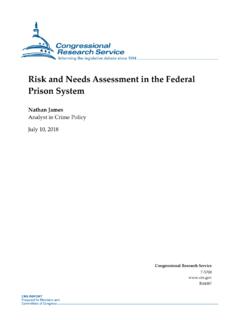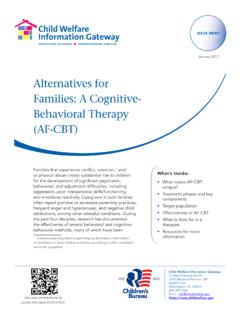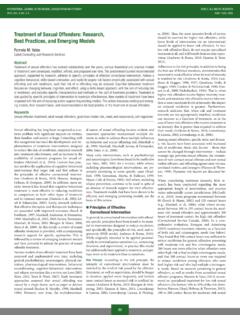Transcription of Juvenile Transfer Laws: An Effective Deterrent to Delinquency
1 Department of Justice Office of Justice Programs Office of Juvenile Justice and Delinquency Prevention Jeff Slowikowski, Acting Administrator June 2010 Office of Justice Programs Innovation Partnerships Safer Neighborhoods Juvenile Transfer Laws: An Effective Deterrent to A Message From OJJDP In an effort to strengthen the sanctions for serious Juvenile crimes, a number of States have enacted laws increas-ing the types of offenders and offens-es eligible for Transfer from the Juvenile court to the adult criminal court for trial and potential sentencing. These laws have lowered the mini-mum Transfer age, increased the number of offenses eligible for trans-fer, and limited judicial discretion, while expanding prosecutorial discre-tion for transfers. Among the principal goals of such Transfer laws are the deterrence of Juvenile crime and a reduction in the rate of recidivism , but what does the research indicate about their effec-tiveness in addressing these ends?
2 Several studies have found higher recidivism rates for juveniles convict-ed in criminal court than for similar offenders adjudicated in Juvenile courts. The research is less clear, however, in regard to whether Transfer laws deter potential Juvenile offenders. This Bulletin provides an overview of research on the Deterrent effects of transferring youth from Juvenile to criminal courts, focusing on large-scale comprehensive OJJDP-funded studies on the effect of Transfer laws on recidivism . It is our hope that the information pro-vided in this Bulletin will help inform public discussion and policy decisions on the Transfer of Juvenile offenders to adult criminal courts. Delinquency ? Richard E. Redding Beginning in the 1980s, many States passed legal reforms designed to get tough on Juvenile crime. One important reform was the revision of Transfer (also called waiver or certification) laws (Grif fin, 2003) to expand the types of offenses and offenders eligible for Transfer from the Juvenile court for trial and sentencing in the adult criminal These reforms lowered the minimum age for Transfer , increased the number of Transfer -eligible offenses, or expanded prosecutorial dis cretion and reduced judicial discretion in Transfer decisionmaking (Fagan and Zimring, 2000; Redding, 2003, 2005).
3 In 1979, for example, 14 States had automatic Transfer statutes requiring that certain Juvenile offenders be tried as adults; by 1995, 21 States had such laws, and by 2003, 31 States (Steiner and Hemmens, 2003). In addition, the age at which juve nile court jurisdiction ends was lowered to 15 or 16 years in 13 States (see Snyder and Sickmund, 2006), although very recently, some States have reduced the scope of Transfer laws (Bishop, 2004), and one State has raised the age at which juve nile court jurisdiction ends from 16 to 18. In the wake of these legislative changes, the number of youth convicted of felonies in criminal courts and incarcerated in adult correctional facilities has increased (Redding, 2003), reaching a peak in the mid-1990s and then declining somewhat (Snyder and Sickmund, 2006) due, in part, to the decrease in Juvenile crime. An esti mated 4,100 youth were committed to State adult prisons in 1999, representing 1 percent of new prison commitments (Snyder and Sickmund, 2006).
4 Sixty-one percent of these youth were incarcerated for person offenses, 23 percent for property offenses, 9 percent for drug offenses, and 5 percent for public order offenses ( , weapons possession) (Snyder and Sick mund, 2006). Transferred juveniles, partic ularly those convicted of violent offenses, typically receive longer sentences than those sentenced in the Juvenile court for similar crimes (Bishop, 2000; Kupchik, Fagan, and Liberman, 2003; Myers, 2005; Virginia Department of Criminal Justice Services, 1996). But, they may be released on bail for a considerable period of time while they await trial in the criminal court (Myers, 2005), and many youth incarcerat ed in adult facilities serve no longer than the maximum time they would have served in a Juvenile facility (Bishop, 2000; Fritsch, Caeti, and Hemmens, 1996; Myers, 2001). Seventy-eight percent were released from prison before their 21st birthday, and 95 percent were released before their Access OJJDP publications online at Types of Transfer Laws While the age at which juveniles can be transferred to the adult system varies across States, most States will Transfer youth ages 14 and older who have com mitted a serious violent offense.
5 Typically, there are four categories of offenses for which juveniles of a certain age may be transferred: (a) any crime, (b) capital crimes and murder, (c) certain violent felonies, and (d) certain crimes committed by juveniles with prior records (Snyder and Sickmund, 2006). (See Griffin, 2003, and Snyder and Sickmund, 2006, for recent comprehensive lists of States, recent Transfer statutes, and statutory requirements.) There are three types of Transfer laws, all of which are referred to in this Bulletin: legislative (automatic Transfer ), judicial-discretionary (judicial Transfer ), and prosecutorial-discretionary (prosecutorial direct-file). Each type defines the kind of Juvenile offender eligible for Transfer under the statute, typically specifying cer tain offenses and minimum age criteria. Most States have two or three coexisting types of Transfer laws (Redding and Mrozoski, 2005). For example, 40 States and the District of Columbia have judicial and prosecutorial Transfer statutes, with the prosecutorial statutes often applicable only to older and more serious offenders (Sanborn, 2003).
6 Automatic Transfer laws, currently in effect in 29 States (Snyder and Sickmund, 2006), require Transfer of a Juvenile if statutory criteria are met (for example, alleged commission of a violent felony by juveniles 14 years of age and older). Under these laws, the case either originates in criminal court, or originates in juve nile court and is then transferred to criminal court. Judicial Transfer laws, currently in 45 States and the District of Columbia (Snyder and Sickmund, 2006), vest dis cretion with the Juvenile court judge to decide whether a Juvenile should be trans ferred after the prosecution files a Transfer motion. Prosecutorial direct-file laws, currently in 14 States and the District of Columbia (Snyder and Sickmund, 2006), vest the discretion with prosecutors, allowing them to decide whether to file charges in the Juvenile or criminal court. Twenty-five States also have reverse waiver laws (Snyder and Sickmund, 2006).
7 In a reverse waiver jurisdiction, the criminal court judge has the discretion to Transfer the defendant back to the Juvenile court (or to treat the defendant as a Juvenile for sentencing purposes). 25th birthday, with an average of 2 years, 8 months of time served on their sentences (Snyder and Sickmund, 2006). General and Specific Deterrence The nationwide policy shift toward trans ferring Juvenile offenders to the criminal court is based largely on the assumption that more punitive, adult criminal sanc tions will act as a Deterrent to Juvenile crime. In terms of specific deterrence in other words, whether trying and sentenc ing Juvenile offenders as adults decreases the likelihood that they will reoffend six large-scale studies have found higher recidivism rates among juveniles convicted for violent offenses in criminal court when compared with similar offenders tried in Juvenile court. With respect to general deterrence whether Transfer laws deter any would-be Juvenile offenders the picture is less clear.
8 The studies on this issue have produced somewhat conflicting findings; however, the bulk of the empirical evidence suggests that Transfer laws have little or no general Deterrent effect. This Bulletin reviews all of the extant research on the general and specific Deterrent effects of transferring juveniles to adult criminal court (Redding, 2005), focusing in particular on recent large-scale studies on specific deterrence funded by the Office of Juvenile Justice and Delin quency Prevention (Fagan, Kupchik, and Liberman, 2003; Lane et al., 2002; Lanza-Kaduce et al., 2005). It also identifies gaps in the field s knowledge base, notes chal lenges for further research, and discusses whether Effective deterrence may be achieved through Transfer . General Deterrence: Do Transfer Laws Prevent Juvenile Crime? Two studies conducted in the 1980s found that Transfer laws did not lower Juvenile crime rates. Jensen and Metsger s (1994) time-series analysis for the years 1976 to 1986 found a 13-percent increase in arrest rates for violent crime committed by 14 to 18-year-olds in Idaho after the State implemented its Transfer law in 1981.
9 In comparison, between 1982 and 1986, the arrest rates for similarly aged juveniles decreased in the neighboring States of Montana and Wyoming (which retained Transfer procedures similar to those Idaho had before 1981). In a similar time-series analysis comparing Juvenile arrest rates between 1974 and 1984 in New York and Philadelphia, Singer and McDowall (1988) found that a 1978 New York State law that automatically sent violent Juvenile offend ers to criminal court (by lowering the ages for criminal court jurisdiction to 13 for murder and 14 for assault, arson, bur glary, kidnapping, and rape) had no deter rent effect on violent Juvenile crime. The law was applied widely and publicized extensively in the Although limited, evidence available at the time suggested that Juvenile offenders in New York were aware of the law (Singer and McDowall, 1988). On the other hand, the results of a multi-state analysis for the years 1978 to 1993 suggest that adult sanctions, under cer tain conditions, may have moderate deter rent effects on Juvenile crime (Levitt, 1998).
10 Controlling for demographic and economic variables, the researchers com pared the Juvenile arrest rates for violent crime across States as a function of each State s minimum age for criminal court jurisdiction to the relative punitiveness of its Juvenile and criminal justice systems. Punitiveness is defined as the ratio of the number of incarcerated offenders to the number of total offenders in each State system for different age groups. Re searchers found relative decreases in youth crime as youth reached the age of criminal responsibility, but only in those States in which Juvenile and criminal justice systems differed significantly in severity of punishment. This suggests that significantly more punitive punishments meted out by criminal courts may deter youth from offending once they reach the age of criminal responsibility. Two multistate studies reached a different conclusion. Examining data on all felony arrests in the State of Florida between 1989 and 2002, including each offender s age and arrest history, Lee and McCrary (2005) evaluated the effect of turning age 18 on criminal offending.














